
The Hubble sequence is a morphological classification scheme for galaxies published by Edwin Hubble in 1926. It is often colloquially known as the Hubble tuning-fork diagram because the shape in which it is traditionally represented resembles a tuning fork. It was invented by John Henry Reynolds and Sir James Jeans.

An elliptical galaxy is a type of galaxy with an approximately ellipsoidal shape and a smooth, nearly featureless image. They are one of the four main classes of galaxy described by Edwin Hubble in his Hubble sequence and 1936 work The Realm of the Nebulae, along with spiral and lenticular galaxies. Elliptical (E) galaxies are, together with lenticular galaxies (S0) with their large-scale disks, and ES galaxies with their intermediate scale disks, a subset of the "early-type" galaxy population.

A lenticular galaxy is a type of galaxy intermediate between an elliptical and a spiral galaxy in galaxy morphological classification schemes. It contains a large-scale disc but does not have large-scale spiral arms. Lenticular galaxies are disc galaxies that have used up or lost most of their interstellar matter and therefore have very little ongoing star formation. They may, however, retain significant dust in their disks. As a result, they consist mainly of aging stars. Despite the morphological differences, lenticular and elliptical galaxies share common properties like spectral features and scaling relations. Both can be considered early-type galaxies that are passively evolving, at least in the local part of the Universe. Connecting the E galaxies with the S0 galaxies are the ES galaxies with intermediate-scale discs.

IC 10 is an irregular galaxy in the constellation Cassiopeia. It was discovered by Lewis Swift in 1887 and in 1935 Nicholas Mayall became the first to suggest that the object is extragalactic. Edwin Hubble suspected it might belong to the Local Group of galaxies, but its status remained uncertain for decades. The radial velocity of IC 10 was measured in 1962, and it was found to be approaching the Milky Way at approximately 350 km/s, strengthening the evidence for its membership in the Local Group. Its membership in the group was finally confirmed in 1996 by direct measurements of its distance based on observations of Cepheids; most estimates place the galaxy 2-3 million light years from Earth, with some estimates ranging from 1.5-4.5 million light years. Despite its closeness, the galaxy is rather difficult to study because it lies near the plane of the Milky Way and is therefore heavily obscured by interstellar matter.

Galaxy morphological classification is a system used by astronomers to divide galaxies into groups based on their visual appearance. There are several schemes in use by which galaxies can be classified according to their morphologies, the most famous being the Hubble sequence, devised by Edwin Hubble and later expanded by Gérard de Vaucouleurs and Allan Sandage. However, galaxy classification and morphology are now largely done using computational methods and physical morphology.

A barred spiral galaxy is a spiral galaxy with a central bar-shaped structure composed of stars. Bars are found in about two thirds of all spiral galaxies in the local universe, and generally affect both the motions of stars and interstellar gas within spiral galaxies and can affect spiral arms as well. The Milky Way Galaxy, where the Solar System is located, is classified as a barred spiral galaxy.

A dwarf galaxy is a small galaxy composed of about 1000 up to several billion stars, as compared to the Milky Way's 200–400 billion stars. The Large Magellanic Cloud, which closely orbits the Milky Way and contains over 30 billion stars, is sometimes classified as a dwarf galaxy; others consider it a full-fledged galaxy. Dwarf galaxies' formation and activity are thought to be heavily influenced by interactions with larger galaxies. Astronomers identify numerous types of dwarf galaxies, based on their shape and composition.

NGC 1569 is a dwarf irregular galaxy in Camelopardalis. The galaxy is relatively nearby and consequently, the Hubble Space Telescope can easily resolve the stars within the galaxy. The distance to the galaxy was previously believed to be only 2.4 Mpc. However, in 2008 scientists studying images from Hubble calculated the galaxy's distance at nearly 11 million light-years away, about 4 million light-years farther than previously thought, meaning it is a member of the IC 342 group of galaxies.
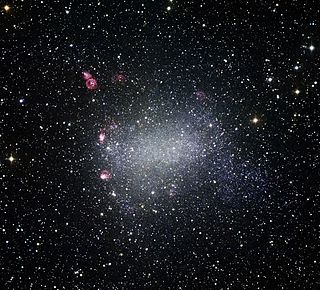
NGC 6822 is a barred irregular galaxy approximately 1.6 million light-years away in the constellation Sagittarius. Part of the Local Group of galaxies, it was discovered by E. E. Barnard in 1884, with a six-inch refractor telescope. It is the closest non-satellite galaxy to the Milky Way, but lies just outside its virial radius. It is similar in structure and composition to the Small Magellanic Cloud. It is about 7,000 light-years in diameter.

Interacting galaxies are galaxies whose gravitational fields result in a disturbance of one another. An example of a minor interaction is a satellite galaxy disturbing the primary galaxy's spiral arms. An example of a major interaction is a galactic collision, which may lead to a galaxy merger.
Magellanic spiral galaxies are (usually) dwarf galaxies which are classified as the type Sm. They are galaxies with one single spiral arm, and are named after their prototype, the Large Magellanic Cloud, an SBm galaxy. They can be considered to be intermediate between dwarf spiral galaxies and irregular galaxies.
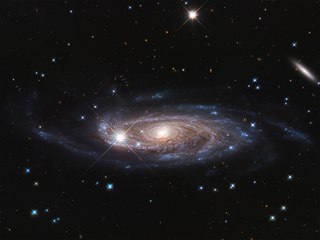
UGC 2885 is a large barred spiral galaxy of type SA(rs)c in the constellation Perseus. It is 232 million light-years (71 Mpc) from Earth and measures 463,000 ly (142,000 pc) across, making it one of the largest known spiral galaxies. It is also a possible member of the Pisces-Perseus supercluster.
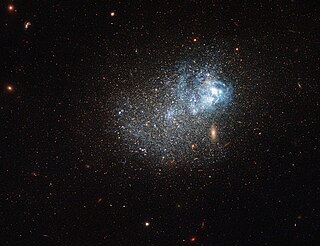
I Zwicky 36, often abbreviated to I Zw 36, is a galaxy in the constellation of Canes Venatici. It is located at a distance of about 5.8 megaparsecs from the Milky Way.

NGC 4707 is an irregular galaxy in the constellation of Canes Venatici. It was discovered by John Herschel on 5 June 1834, and was described by John Louis Emil Dreyer, the compiler of the New General Catalogue, as a "small, stellar" galaxy.

NGC 5264, also known as DDO 242, is an irregular galaxy in the constellation Hydra. It is part of the M83 subgroup of the Centaurus A/M83 Group, located some 15 million light years away. The galaxy was discovered on 30 March 1835 by John Herschel, and it was described as "very faint, pretty large, round, very little brighter middle" by John Louis Emil Dreyer, the compiler of the New General Catalogue.
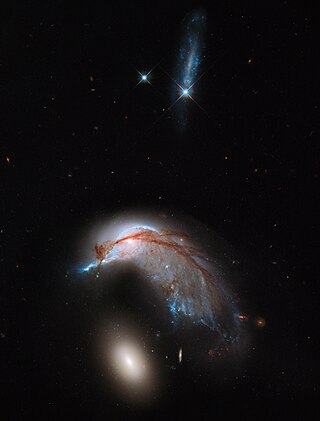
NGC 2936 is an interacting spiral galaxy located at a distance of 326 million light years, in the constellation Hydra. NGC 2936 is interacting with elliptical galaxy NGC 2937, located just beneath it. They were both discovered by Albert Marth on Mar 3, 1864. To some astronomers, the galaxy looks like a penguin or a porpoise. NGC 2936, NGC 2937, and PGC 1237172 are included in the Atlas of Peculiar Galaxies as Arp 142 in the category "Galaxy triplet".

IC 4710 is a galaxy in southern constellation of Pavo, roughly 34 million light-years away.
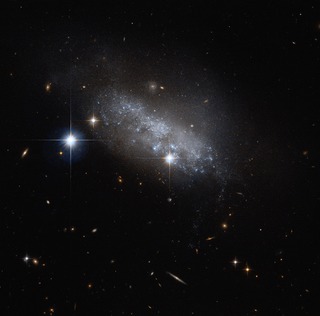
IC 3583 is an irregular galaxy some 30 million light-years away in the constellation of Virgo. It was discovered by Isaac Roberts on April 29, 1892.
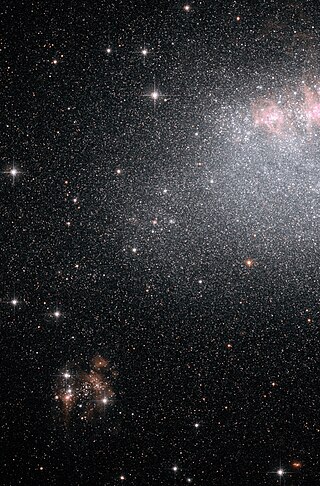
IC 4662, also known as ESO 102-14 is an irregular galaxy located in the constellation Pavo 7.96 million light years away. It was discovered by Robert T. A. Innes in 1901. It has a diameter of 7000 light years and an angular size of 3.2' x 1.9'.
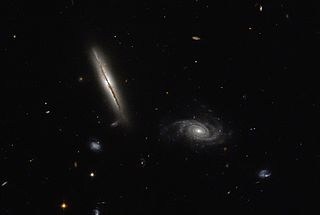
ESO 0313-192 is a edge-on spiral galaxy, or a double-lobed radio galaxy around 900 million light-years away in the constellation Eridanus. Its radio jets were discovered in 2003 by NASA, and its radio lobes are an estimated 1.5 million light years in diameter. It is part of the cluster Abell 428, and it has an active galactic nuclei.



























